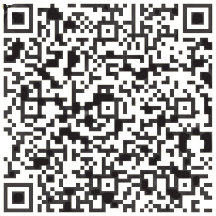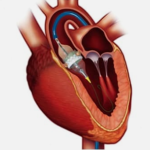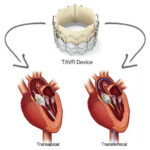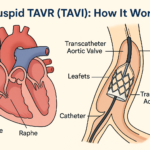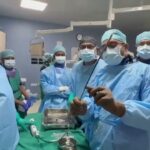 9 January, 2025
9 January, 2025
Management of Giant Coronary Aneurysm with Thrombus
-
Introduction
A 34-year-old male presented for further management after suffering an acute inferior wall myocardial infarction (MI), which was thrombolyzed successfully at another facility. While the electrocardiogram (ECG) showed good resolution, further evaluation was warranted due to persistent symptoms and underlying pathology.
Diagnostic Challenges
Conventional coronary angiography and cardiac CT were unable to adequately delineate the coronary anatomy. Therefore, bilateral injections were performed using a pressure injector, along with a selective aneurysmogram using a guide extension catheter.
Key Findings:
- Giant aneurysm originating from the right coronary artery (RCA) with a wide neck, devoid of any significant branches.
- Layered thrombus was observed within the aneurysm along with a large, highly mobile thrombus at the wide-neck area.

Advanced Imaging
Intravascular Ultrasound (IVUS) was conducted to gain detailed insights. The findings revealed:
- A wide-necked aneurysm with dimensions of 5 mm in the distal RCA and 6 mm proximally.
This detailed imaging provided essential information for planning the intervention and assessing potential risks.
A wide-necked aneurysm with dimensions of 5 mm in the distal RCA and 6 mm proximally.
Treatment Planning
After thorough discussion with the heart team, the decision was made to exclude the aneurysm and the ball thrombus with a covered stent. However, several challenges emerged:
- No covered stents were available for coronary arteries of such diameter.
- Peripheral stents that were available required a 0.035 or 0.018-inch guidewire system, which was incompatible due to the tortuosity of the coronary anatomy.
- The highly mobile thrombus posed a significant risk of distal embolization during the procedure.
Innovative Approach
Given the challenges, the team employed a novel and customized approach to address the patient’s condition effectively.
- A “mother-and-child system” was utilized by introducing an 8 Fr Shuttle sheath femorally to ensure stable access.
- A coronary AL1 catheter was carefully used to intubate the RCA and facilitate maneuverability.
Wiring and Protection
- A through-and-through coronary loop was established by exteriorizing an RG 300 CTO wire from the RCA to the left coronary artery (LCA) (exteriorized through the right radial artery).
- This technique minimized the risk of coronary dissection while maintaining stability during the procedure.
To mitigate the risk of cheese-wiring and tension-related coronary injury, a Corsair 150 retrograde system was employed to provide additional protection and stability.
Stent Deployment
The procedure required precision in navigating a bulky covered stent into the coronary anatomy. The following steps were undertaken:
- A Bentley Graft 5×38 mm stent was deployed first, excluding the proximal part of the aneurysm.
- Subsequently, a Bentley Graft 6×58 mm stent was used to seal the remaining aneurysm neck.
Both stents were “moonwalked” into position in synchronization with the Corsair system, ensuring accurate placement without the need for cheese wiring.
Post-Dilation:
- A 6 mm balloon was used to post-dilate the stents at the inflow and outflow regions, ensuring proper expansion and optimal blood flow.
Outcome and Follow-Up
The final angiogram revealed excellent results:
- Complete exclusion of the aneurysm with no residual filling.
- Restored blood flow without any obstruction or turbulence.
- No signs of dissection or damage to the RCA or LCX.
The patient’s post-procedure recovery was uneventful. He was discharged on:
- Aspirin and Plavix for dual antiplatelet therapy.
- Lifelong anticoagulation with Acitrom to prevent future thrombotic complications.
A discharge echocardiogram confirmed good left ventricular (LV) function, with no evidence of further cardiac compromise.
Discussion
This case highlights the challenges of managing a rare coronary pathology like a giant aneurysm with a highly mobile thrombus. The innovative use of advanced imaging, customized interventional techniques, and teamwork ensured a successful outcome in a high-risk scenario. Key takeaways include:
- The importance of multidisciplinary collaboration in managing complex cases.
- The role of advanced imaging tools like IVUS in planning and executing precise interventions.
- Adopting novel techniques like the “mother-and-child system” to overcome anatomical and technical challenges.
FAQs
1. What is a coronary aneurysm?
A coronary aneurysm is an abnormal dilatation or bulging of a section of a coronary artery, which can pose risks like thrombosis, rupture, or embolization.
2. Why is a coronary aneurysm dangerous?
Coronary aneurysms can lead to complications such as blood clots, restricted blood flow, and even life-threatening ruptures if left untreated.
3. How was the aneurysm treated in this case?
The aneurysm was excluded using a combination of covered stents, advanced imaging techniques, and innovative interventional methods like the mother-and-child system.
4. What challenges were faced during this procedure?
Challenges included the unavailability of suitable coronary covered stents, the tortuous coronary anatomy, and the presence of a highly mobile thrombus.
5. What is the significance of “moonwalking” the stent?
“Moonwalking” refers to a synchronized movement technique to navigate and position the bulky stent without causing damage to the delicate coronary arteries.
6. What medications were prescribed post-procedure?
The patient was prescribed Aspirin and Plavix for dual antiplatelet therapy, along with lifelong anticoagulation using Acitrom.
7. How does IVUS aid in such cases?
IVUS provides detailed cross-sectional images of the coronary artery, enabling precise assessment of aneurysm size, structure, and the surrounding anatomy for better planning.




